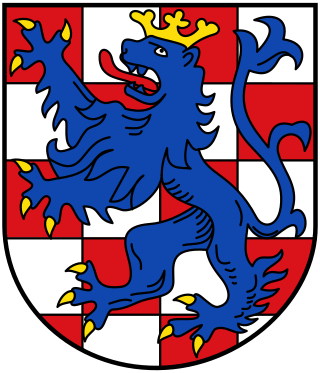
Salm is the name of several historic countships and principalities in present Germany, Belgium, Luxembourg and France.
Salm-Kyrburg was a state of the Holy Roman Empire located in present-day Rhineland-Palatinate, Germany, one of the various partitions of Salm. It was twice created: the first time as a Wild- and Rhinegraviate, and secondly as a Principality. The first state of Salm-Kyrburg was partitioned between itself, Salm-Mörchingen and Salm-Tronecken in 1607, and was inherited by Salm-Neuweiler in 1681 upon the lines' extinction.

Juliana, Countess of Stolberg-Wernigerode was the mother of William the Silent, the leader of the successful Dutch Revolt against the Spanish in the 16th century.

Hochstetten-Dhaun is an Ortsgemeinde – a municipality belonging to a Verbandsgemeinde, a kind of collective municipality – in the Bad Kreuznach district in Rhineland-Palatinate, Germany. It belongs to the Verbandsgemeinde Kirner Land, whose seat is in the town of Kirn. Hochstetten-Dhaun is a state-recognized recreational community.

Philip Joseph, Prince of Salm-Kyrburg (1709–1779) was the first prince of Salm-Kyrburg, from 1743 to 1779.

William Louis of Nassau-Saarbrücken, was a Count of Saarbrücken.
John Louis, Count of Nassau-Ottweiler (23 May 1625, Saarbrücken – 9 February 1690, Reichelsheim, was first Count of Nassau-Ottweiler. At times, he was Major General, Regent of the other Nassau territories and chief of the House of Nassau.

Otto Louis of Salm, Wild- and Rhinegrave of Kyrburg and Mörchingen was a Swedish general during the Thirty Years' War. He was governor in the Alsace and Commander of the Swedish troops in the Upper Rhine. He died of the plague at Speyer and was buried in Strasbourg Cathedral.

Albert of Nassau-Weilburg-Ottweiler, was a count of the House of Nassau. His territory included the areas around Weilburg, Ottweiler and Lahr in the Black Forest. Like his father, Philip III of Nassau-Weilburg he was an advocate of the Reformation.

Countess Palatine Dorothea Catherine of Birkenfeld-Bischweiler was a Countess Palatine of Zweibrücken-Birkenfeld-Bischweiler by birth and, by marriage, Countess of Nassau-Ottweiler.

Frederick Louis of Nassau-Ottweiler was a member of the House of Nassau.

Count John of Nassau-Idstein was Count of Nassau and Protestant Regent of Idstein.
John IX of Salm-Kyrburg-Mörchingen (1575–1623) was Wild- and Rhinegrave of Kyrburg and Count of Salm. He was the son of Otto I (1538–1607) and Ottilie of Nassau-Weilburg. Many of his relatives served as soldiers in Swedish service, including his brother John Casimir of Salm-Kyrburg (1577–1651). Because of this, the family was often on the run during the Thirty Years' War.

John, Count Palatine of Gelnhausen was Count Palatine and Duke of Zweibrücken-Birkenfeld at Gelnhausen.
Anna Catherine of Nassau-Ottweiler was a daughter of John Louis, Count of Nassau-Ottweiler and his wife, Countess Palatine Dorothea Catherine of Birkenfeld-Bischweiler. She was styled "Countess of Nassau-Ottweiler".

Louis Henry of Nassau-Dillenburg, was Count, and from 1654 Prince of Nassau-Dillenburg. During the Thirty Years' War, he was a senior officer. He climbed to the rank of Major General. Before 1635, he served on the Protestant side; after 1635, he served in the imperial army.
John Philip II of Salm-Dhaun was Rhinegrave of Salm-Dhaun from 1673 until his death. He was the son of Count John Louis of Salm-Dhaun and his wife, Elisabeth of Salm-Neufville.

Count William Wirich of Daun-Falkenstein was a German nobleman. By descent, he was a Count of Falkenstein; by inheritance, he was Lord of Broich and Bürgel.
Christian Otto, Wild- and Rhinegrave of Salm-Dhaun was Wild- and Rhinegrave of Salm-Dhaun from 1742 until his death. He was the son of John Philip II and his wife Anna Catherine of Nassau-Ottweiler.
John Philip III, Wild- and Rhinegrave of Salm-Dhaun was a German nobleman. He was the ruling Wild- and Rhinegrave of Salm-Dhaun from 1733 until his death. He was the son of Wild- and Rhinegrave Charles and his wife Louise, a daughter of Frederick Louis, Count of Nassau-Ottweiler.
This page is based on this
Wikipedia article Text is available under the
CC BY-SA 4.0 license; additional terms may apply.
Images, videos and audio are available under their respective licenses.












